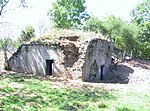Centre-Chapelle des Buis, also known as La Boucle, is the district corresponding to the historic center of the city of Besançon. The name La Boucle comes from the meander of the Doubs in which the city originally developed, and whose very shape is that of a loop (Bucle). Until the second half of the 19th century, this district, along with Battant, was the only part of the city of Besançon, before urban expansion into the surrounding areas. The district had a population of 10,659 habitants in 2018, making it the city's sixth most populous district.
The economic heart of the city, La Boucle is home to the vast majority of the city's shops and services, as well as virtually all government offices. Thanks to its flourishing past, the district boasts the city's richest and most complete architectural heritage, with around a hundred remarkable buildings, dozens of statues and several bridges, squares and streets. The district is also one of the city's and region's most popular tourist destinations, thanks in particular to the Citadelle de Besançon, one of the city's most representative monuments, welcoming more than 250,000 visitors every year.









